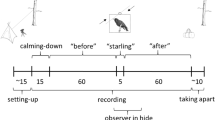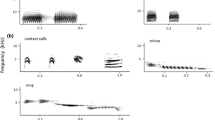Summary
Nest defence behaviour of four corvid species towards a common foe, the carrion crow, was examined. The various species responded quite differently when a caged crow was presented near the nest. Compared with the other species magpies attacked the caged crow most often. Rooks were very vociferous and circled much above the crow. Jackdaws usually perched nearby; occasionally, they circled over and scolded at the crow. Crows flew off and frequently started to forage at a distance, behaving as though nothing alarming was happening near their nest. These differences in nest defence behaviour have been related to inter- as well as intraspecific variations in nesting conditions, including accessibility, camouflage, site, dispersion and construction of nests. Behavioural responses and nesting conditions are finely tuned and can be considered as elements of adaptive complexes promoting the safety of the nest.
Similar content being viewed by others
References
Baeyens G (1981) Magpie breeding success and carrion crown interference. Ardea 69: 125–139
Bossema I, Röell A, Baeyens G, Zeevalking H, Leever H (1976) Interspecifieke agressie en sociale organisatie bij onze inheemse Corviden. Levende Natuur 79: 149–166
Boucher DH (1977) On wasting parental investment. Am Natur 111: 786–788
Charles JK (1972) Territorial behaviour and the limitation of population size in the crow Corvus corone and Corvus cornix. PhD thesis, University of Aberdeen
Cullen E (1957) Adaptations in the kittiwake to cliff-nesting. Ibis 99: 275–302
Dawkins R, Carlisle TR (1976) Parental investment, mate desertion and a fallacy. Nature 262: 131–132
Erpino MJ (1968) Nest-related activities of black-billed magpies. Condor 70: 154–165
Goodwin D (1976) Crows of the world. Cornell University Press, New York
Gottfried BM (1979) Anti-predator aggression in birds nesting in old field habitats: an experimental analysis. Condor 81: 251–257
Holyoak D (1967) Breeding biology of the Corvidae. Bird Study 14: 153–168
Holyoak D (1968) A comparative study of the food of some British Corvidae. Bird Study 15: 147–153
Kruuk H (1976) The biological function of gull's attraction towards predators. Anim Behav 24: 146–153
Lockie JD (1955) The breeding and feeding of jackdaws and rooks with notes on carrion crows and other Corvidae. Ibis 97: 341–369
Lockie JD (1956) Winter fighting in feeding flocks of rooks, jackdaws and carrion crows. Bird Study 3: 180–190
Röell A (1978) Social behaviour of the jackdaw, Corvus monedula, in relation to its niche. Behaviour 64: 1–124
Trivers RL (1972) Parental investment and sexual selection. In: Sexual selection and the descent of man. Alding, Chicago, Michigan
Wittenberg J (1968) Freilanduntersuchungen zu Brutbiologie und Verhalten der Rabenkrähe (Corvus c. corone). Zool Jahrb Syst 95: 16–146
Yom-Tov Y (1974) The effect of food and predation on breeding density and success, clutch size and laying date of the crow, Corvus corone L: an experimental approach. J Anim Ecol 43: 479–498
Author information
Authors and Affiliations
Rights and permissions
About this article
Cite this article
Röell, A., Bossema, I. A comparison of nest defence by Jackdaws, rooks, magpies and crows. Behav Ecol Sociobiol 11, 1–6 (1982). https://doi.org/10.1007/BF00297658
Received:
Accepted:
Issue Date:
DOI: https://doi.org/10.1007/BF00297658




